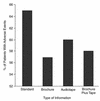The Effect of Brochures and Audiotape on Efficacy and Tolerability of Venlafaxine in Depressed Outpatients: A Single-Blind Parallel Study in General Practice
- PMID: 15014654
- PMCID: PMC181114
- DOI: 10.4088/pcc.v02n0303
The Effect of Brochures and Audiotape on Efficacy and Tolerability of Venlafaxine in Depressed Outpatients: A Single-Blind Parallel Study in General Practice
Abstract
OBJECTIVE: The possible positive effects of brochures and an audiotape containing information on efficacy and tolerance on side effects, dropout rate, and clinical outcome of treatment with venlafaxine were studied in 1048 depressed outpatients (as clinically judged by the general practitioner; 740 women and 308 men), aged 18 to 85 years. METHOD: The study was of a single-blind, parallel-group design. All 4 groups were verbally informed: one group received only verbal information, a second group additionally received brochures, a third group additionally received information on audiotape, and a fourth group additionally received brochures and information on audiotape. There were 5 study visits, the first at baseline (week 0), followed by a visit at weeks 1, 2, 4, and 6. At each study visit, the Clinical Global Impressions scale, Zung Depression Scale, Quality of Life Scale, and State-Trait Anxiety Inventory were completed. The Patient's and Investigator's Subjective Ratings of Tolerance and Efficacy were completed at the final study visit. RESULTS: The brochures and audiotape reduced the dropout rate due to lack of efficacy (p =.01 and p =.04, respectively). In addition, the percentage of patients reporting side effects was lower in the group that received brochures than in the group that received only verbal information (p =.05). Additional information had no effect on efficacy measures. CONCLUSION: Supplying patients with education in the form of brochures and/or audiotape containing information on efficacy and tolerance of the drug reduces the dropout rate due to lack of efficacy. For the reduction of side effects, brochures in particular seem suitable. Information on audiotape or written information seems to lengthen the period that patients wait for the possible beneficial action of the medication. To reduce the dropout rate, it may be recommended that patients receive, in addition to brochures, spoken information on audiotape or compact disc.
Figures
Similar articles
-
The influence of type of information, somatization, and locus of control on attitude, knowledge, and compliance with respect to the triphasic oral contraceptive Tri-Minulet.Contraception. 1997 Jul;56(1):31-41. doi: 10.1016/s0010-7824(97)00071-1. Contraception. 1997. PMID: 9306029 Clinical Trial.
-
Efficacy of venlafaxine extended-release capsules in nondepressed outpatients with generalized anxiety disorder: A 6-month randomized controlled trial.JAMA. 2000 Jun 21;283(23):3082-8. doi: 10.1001/jama.283.23.3082. JAMA. 2000. PMID: 10865302 Clinical Trial.
-
A single-tablet fixed-dose combination of racemic ibuprofen/paracetamol in the management of moderate to severe postoperative dental pain in adult and adolescent patients: a multicenter, two-stage, randomized, double-blind, parallel-group, placebo-controlled, factorial study.Clin Ther. 2010 Jun;32(6):1033-49. doi: 10.1016/j.clinthera.2010.06.002. Clin Ther. 2010. PMID: 20637958 Clinical Trial.
-
Novel Augmentation Strategies in Major Depression.Dan Med J. 2017 Apr;64(4):B5338. Dan Med J. 2017. PMID: 28385173 Review.
-
The effect of educational audiotape programme on anxiety and depression in patients undergoing coronary artery bypass graft.J Clin Nurs. 2013 Jun;22(11-12):1613-9. doi: 10.1111/jocn.12125. Epub 2013 Mar 6. J Clin Nurs. 2013. PMID: 23461482 Clinical Trial.
Cited by
-
The impact of informing psychiatric patients about their medication: a systematic review.Pharm World Sci. 2006 Dec;28(6):329-41. doi: 10.1007/s11096-006-9054-2. Epub 2007 Jan 10. Pharm World Sci. 2006. PMID: 17216295
References
-
- Posavac EJ, Sinacore JM, Brotherton SE, et al. Increasing compliance with medical treatment regimens: a meta-analysis of program evaluation. Eval Health Prof. 1985;8:7–22.
-
- Haynes RB, Wang E, da Mota GM, et al. A critical review of interventions to improve compliance with prescribed medications. Patient Educ Couns. 1987;10:155–166.
-
- Jay S, Litt IF, Durant RH. Compliance with therapeutic regimens. J Adolesc Health Care. 1984;5:124–136. - PubMed
-
- Eraker SA, Kirscht JP, Becker MH. Understanding and improving patient compliance. Ann Intern Med. 1984;100:258–268. - PubMed
-
- Cramer JA, Rosenheck R. Compliance with medication regimens for mental and physical disorders. Psychiatr Serv. 1998;49:196–201. - PubMed
LinkOut - more resources
Full Text Sources

